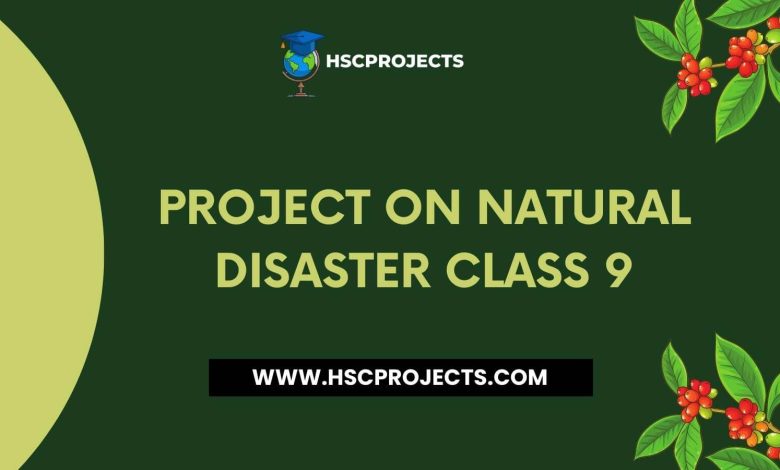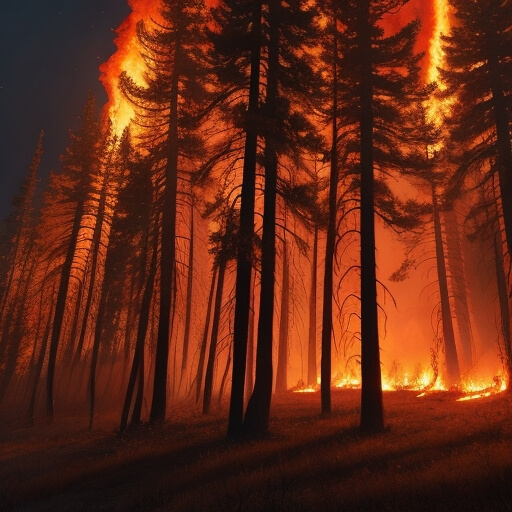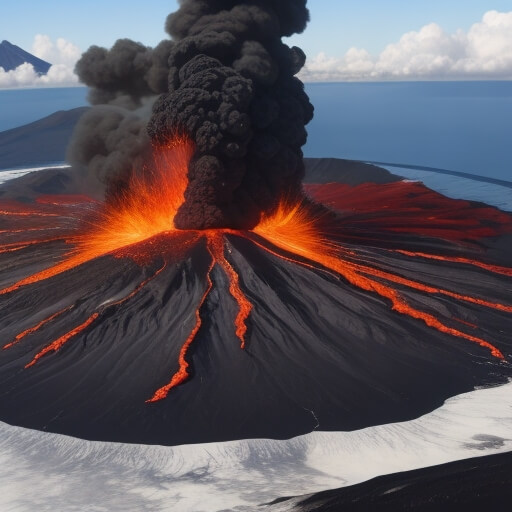
Project On Natural Disaster Class 9
WHAT IS A DISASTER?
Picture a disaster as a sudden, unforeseen event or a chain of occurrences that unleashes widespread havoc, snatches away lives, and inflicts substantial harm on property and the natural world. It’s the kind of thing that can catch you off guard, arising from the forces of nature or human actions. These calamities hit hard, causing chaos in communities, shaking economies, and disturbing the balance of ecosystems. Responding to and recovering from such chaos demands swift, well-coordinated efforts.
Now, there are two main categories of disasters to keep in mind. First, there are the natural disasters, the ones set in motion by Mother Nature herself. Think earthquakes, hurricanes, floods, tsunamis, droughts, volcanic eruptions, wildfires, and avalanches. These are wild and untamable, beyond human influence, and they can bring immense devastation.
Then, on the flip side, we have the human-induced disasters. These are often the result of human activities gone awry. Picture industrial accidents, nuclear meltdowns, oil spills, or even acts of terrorism. Man-made or technological disasters that can be equally catastrophic.
Disasters don’t come in one size fits all; they range from small-scale incidents affecting a tight-knit community to large-scale catastrophes that ripple across entire regions or nations. Sometimes, they strike without warning, catching everyone off guard. Other times, they give us a bit of a heads-up, allowing us to brace ourselves.
And remember, disasters don’t just pack a punch in the moment. They can leave a lasting mark on everything from infrastructure to public health, the economy, and the environment. What’s worse, their frequency and ferocity can be influenced by factors like climate change, a growing population, urban expansion, deforestation, and a lack of robust disaster management systems.
In the grand scheme of things, comprehending the essence of disasters, why they occur, and the chaos they can sow is absolutely crucial. It’s the knowledge we need to prepare ourselves, mount an effective response, and work on strategies to reduce their impact, safeguard lives, and forge more resilient communities.
PHASES OF DISASTER MITIGATION
- Preparedness: This initial phase focuses on what we do before disaster strikes. It’s like getting ready for a storm before it hits. We develop emergency response plans, assess the risks we face, and set up early warning systems. It’s all about raising awareness among the public, training our emergency responders, and running drills and simulations to ensure everyone knows what to do when a disaster actually hits.
- Response: When disaster is knocking at our door or has just barged in, it’s time for the response phase. This is the moment when our emergency services swing into action. Search and rescue teams, medical aid providers, and those distributing shelter and food all come into play. The goal here is to act fast, save lives, ease suffering, and meet immediate needs. Coordination is key, with government agencies, humanitarian groups, and local communities working together.
- Recovery: Once the immediate chaos has subsided, we enter the recovery phase. Now, the focus is on rebuilding what’s been torn down. We repair damaged infrastructure, rehabilitate affected areas, offer medical and psychological support to survivors, and help people return to their homes and communities. We also roll up our sleeves to kickstart the local economy and rebuild livelihoods. It’s about getting back on our feet, maybe even stronger than before.
- Mitigation: Now, let’s talk about the phase that’s all about preventing future disasters from packing the same punch. In the mitigation phase, we put measures in place to reduce the risk and impact of potential disasters. We might tighten building codes, make smart land-use plans to avoid high-risk areas, amp up early warning systems, and make our infrastructure more resilient. These efforts often demand long-term planning and investments, but they’re essential to creating communities that can bounce back from adversity.
- Prevention: Although it might not always be singled out as a distinct phase, prevention is like the silent hero of disaster mitigation. It’s about taking proactive steps to stop disasters from happening in the first place. Think of it as guarding our environment, managing natural resources sustainably, and tackling the root causes of vulnerability, like poverty, inequality, and governance issues.
These phases of disaster mitigation form a comprehensive approach that empowers communities to dial down the impact of disasters and bolster their resilience in the face of future challenges. It’s worth noting that disaster mitigation is a continuous, ever-evolving process, shaped by the lessons we learn from past experiences.
TYPES OF DISASTERS
Earthquakes: These seismic events occur when the Earth’s crust undergoes sudden movements. These movements are often caused by tectonic plates colliding, separating, or sliding past each other. Earthquakes can range from mild tremors to violent quakes, leading to ground shaking, building damage, and even tsunamis in coastal areas.

Hurricanes/Cyclones/Typhoons: These are all names for the same type of intense tropical storms. They form over warm ocean waters when moist air rises and creates a low-pressure center, which then spawns strong winds and heavy rains. Coastal regions often bear the brunt of these storms, dealing with high winds, storm surges, and heavy flooding.

Floods: Floods can stem from a variety of causes, including heavy rainfall, rapid snowmelt, dam failures, or coastal storms. When water levels rise significantly, it overflows onto normally dry land. This can inundate homes, infrastructure, and agricultural areas, displacing people and causing substantial damage.

Tsunamis: These massive ocean waves are typically triggered by underwater disturbances. Earthquakes, volcanic eruptions, or landslides beneath the ocean can displace large volumes of water, generating tsunamis. When these waves reach coastal areas, they can flood land, destroy buildings, and pose serious threats to coastal communities.

Droughts: Prolonged periods of abnormally low rainfall characterize droughts. These dry spells can have far-reaching consequences, leading to crop failures, water shortages, and ecological imbalances. The impacts ripple through agriculture, ecosystems, and human populations, often resulting in food scarcity and economic hardships.

Wildfires: Wildfires, also known as forest fires or bushfires, spread quickly through vegetation and forests. They typically ignite in dry conditions due to factors like lightning strikes, human activities, or volcanic events. These fires can destroy large areas of land, threaten human settlements, and release smoke that affects air quality.

Volcanic Eruptions: Volcanic eruptions happen when molten rock, ash, and gases escape from a volcano. This can occur explosively or more gradually. Eruptions can unleash pyroclastic flows (superheated ash and gas), ashfall, lava flows, and toxic gases, impacting nearby areas, communities, and even air travel.

DISASTERS AND EMERGENCY MANAGEMENT
- Preparedness and Education for Disasters: Dive into the effectiveness of disaster preparedness programs across various regions. Evaluate the impact of public education campaigns on disaster awareness and readiness.
- Climate Change’s Influence on Disaster Risk: Explore the intricate relationship between climate change and the frequency or severity of natural disasters. Investigate strategies to mitigate the risks posed by climate-related disasters.
- Response and Recovery in the Face of Disasters: Scrutinize recent disaster case studies to assess the efficacy of emergency response and recovery operations. Uncover opportunities for enhancing disaster management.
- Building Community Resilience: Delve into how communities can bolster their resilience when confronted with disasters. Analyze the factors contributing to community resilience and propose strategies for strengthening it.
- Humanitarian Organizations and Disaster Relief: Examine the roles played by international humanitarian entities in delivering aid during calamities. Dissect the challenges and prospects within the realm of disaster relief.
- Technological Advancements Transforming Disaster Management: Explore the transformative potential of emerging technologies, such as artificial intelligence, drones, and early warning systems, in the realm of disaster management.
- Policies for Disaster Risk Reduction: Investigate governmental policies and initiatives designed to curtail disaster risk. Scrutinize the repercussions of policy decisions on disaster-prone regions.
- Healthcare Readiness for Epidemics: Evaluate the readiness and response of healthcare systems during epidemics or pandemics like COVID-19. Assess the effectiveness of vaccination campaigns and public health measures.
- Urban Planning for Disaster Resilience: Study urban planning approaches that augment a city’s ability to withstand disasters. Explore innovative concepts like “smart cities” and sustainable urban development.
- Environmental Conservation’s Role in Disaster Mitigation: Examine how environmental conservation and sustainable land management can diminish the risk of natural disasters, including floods, wildfires, and landslides.
- Psychological Impacts of Disasters: Explore the psychological toll that disasters inflict on survivors and first responders. Discuss strategies for providing essential mental health support during and after disasters.
- Communication Strategies in Times of Crisis: Analyze the pivotal role of effective communication in disaster management. Investigate how governments, organizations, and communities communicate during crises.
- Learning from the Past: Historical Disasters: Delve into the annals of history to research past disasters and their profound impacts on societies and cultures. Extract valuable lessons that can inform contemporary disaster management.
- Economic Aftermath of Disasters and Recovery: Investigate the economic repercussions of disasters on afflicted regions. Assess the long-term economic effects of recovery efforts.
- Ethical Dilemmas in Humanitarian Response: Probe into the ethical quandaries faced by humanitarian organizations and responders in the midst of disaster situations.
Conclusion
In wrapping up our exploration, let’s dive into the intricate world of disasters and emergency management—a realm brimming with complexity and significance. In the course of this project, we’ve ventured into the heart of disasters, their diverse forms, and the phases of disaster mitigation. We’ve peeled back the layers of disaster preparedness, response, recovery, and mitigation, underlining the pivotal role of proactive measures in lessening disaster impacts and forging resilient communities.
The shadow of climate change looms large, casting its influence on the frequency and ferocity of natural disasters. This compels us to scrutinize strategies for taming its risks. In addition, technology is poised to revolutionize disaster management, with artificial intelligence, drones, and early warning systems poised as vanguards of preparedness and response.
At the governmental level, policies for disaster risk reduction and sustainable urban planning stand as bulwarks of disaster resilience. On the front lines, healthcare readiness and psychological support emerge as equally critical facets, safeguarding the well-being of both survivors and the valiant first responders.
Turning our gaze toward environmental conservation and sustainable land management, we discover promising avenues to shrink the risk of natural disasters. And let’s not forget the ethical compass that guides humanitarian response—a moral imperative that calls for integrity and compassion amid the chaos.
Throughout our journey, we’ve consistently emphasized the lessons borne from history’s disasters—nuggets of wisdom to shape our modern disaster management practices. We’ve also probed the economic aftermath of these cataclysms, unearthing challenges and opportunities for recovery and reconstruction.
In summation, the realm of disaster and emergency management isn’t just about reacting to crises; it’s a symphony of proactive planning, community fortitude, and a relentless pursuit of knowledge. As our world grapples with an ever-evolving tapestry of risks and trials, it’s incumbent upon us to persist in our research, innovation, and collaboration—to craft strategies that safeguard lives, shield communities, and champion sustainable recovery in the face of adversity.
Certificate of Completion
[Student’s Name][Class/Grade Level]This is to certify that I, [Student’s Name], a [Class/Grade Level] student, have successfully completed the project on “Natural Disaster Class 9.” The project explores the fundamental principles and key aspects of the chosen topic, providing a comprehensive understanding of its significance and implications.
In this project, I delved into in-depth research and analysis, investigating various facets and relevant theories related to the chosen topic. I demonstrated dedication, diligence, and a high level of sincerity throughout the project’s completion.
Key Achievements:
Thoroughly researched and analyzed Project On Natural Disaster Class 9.
Examined the historical background and evolution of the subject matter.
Explored the contributions of notable figures in the field.
Investigated the key theories and principles associated with the topic.
Discussed practical applications and real-world implications.
Considered critical viewpoints and alternative theories, fostering a well-rounded understanding.
This project has significantly enhanced my knowledge and critical thinking skills in the chosen field of study. It reflects my commitment to academic excellence and the pursuit of knowledge.
Date: [Date of Completion]Signature: [Your Signature] [School/Institution Name][Teacher’s/Examiner’s Name and Signature]
In order to download the PDF, You must follow on Youtube. Once done, Click on Submit
Follow On YoutubeSubscribed? Click on Confirm
Download Project On Natural Disaster Class 9 PDF






